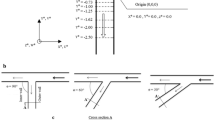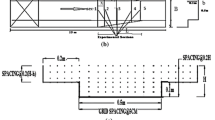Abstract
The existence of hydraulic structures in a branched open channel system urges the need for considering the gradually varied flow criterion in evaluating the different hydraulic characteristics in this type of open channel system. Computations of hydraulic characteristics such as flow rates and water surface profiles in branched open channel system with hydraulic structures require tremendous numerical effort especially when the flow cannot be assumed uniform. In addition, the existence of submerged aquatic weeds in this branched open channel system adds to the complexity of the evaluation of the different hydraulic characteristics for this system. However, this existence of aquatic weeds can not be neglected since it is very common in Egyptian open channel systems.
Artificial Neural Network (ANN) has been widely utilized in the past decade in civil engineering applications for the simulation and prediction of the different physical phenomena and has proven its capabilities in the different fields. The present study aims towards introducing the use of ANN technique to model and predict the impact of submerged aquatic weeds existence on the hydraulic performance of branched open channel system. Specifically the current paper investigates a branched open channel system that consists of main channel supplies water to two branch channels that are infested by submerged aquatic weeds and have water structures such as clear over fall weirs and sluice gates. The results of this study showed that ANN technique was capable, with small computational effort and high accuracy, of predicting the impact of different infestation percentage for submerged aquatic weeds on the hydraulic performance of branched open channel system with two different hydraulic structures.
Similar content being viewed by others
References
Wylie, Benjamin E., 1972, “Water Surface Profiles in Divided Channels,”Journal of Hydraulic Research, Vol. 10, No. 3, pp. 325–341.
Chaudhry, M. H. and Schulte, A. M., 1987, “Gradually Varied Flows in Open Channel Network,”Journal of Hydraulic Research, Vol. 25, No. 3, pp. 357–369.
Delft Hydraulics Research, 1992, “WENDY Model-Version 3.0,” Netherlands.
Ibrahim, H. M., 1997, “Gradually Varied Flow Through an Open Channel’s Junction,” PhD Thesis
Presented to Ain Shams University, Cairo, Egypt. Ibrahim, H. M., El-Samman, T. A. and Abdin, A. E., 2000, “Impact of Changing Water Structure Locations on the Hydraulic Performance of a Branched Hydraulic System,”Sci. Bull. Fac. Eng. Ain Shams Univ., Vol. 35, No. 3.
Tahk, Kyung-Mo and Shin, Kee-Hyun, 2002, “A study on the Fault Diagnosis of Roller-Shape Using Frequency Analysis of Tension Signals and Artificial Neural Networks Based Approach in a Web Transport System,”KSME International Journal, Vol. 16, No. 12.
Park, Ji-Hyung and Seo, Kwang-Kyu, 2003, “Approximate Life Cycle Assessment of Product Concepts Using Multiple Regression Analysis and Artificial Neural Networks,”KSME International Journal, Vol. 17, No. 12.
Chandramouli, V. and Raman, H., 2001, “Multireservoir Modeling With Dynamic Programming and Neural Networks,”Journal of Water Resources Planning and Management, Vol. 127, pp. 89–98.
Abdeen, M. A. M., 2001, “Neural Network Model for Predicting Flow Characteristics in Irregular Open Channels,”Scientific Journal, Faculty of Engineering-Alexandria University, Vol. 40, No. 4, pp. 539–546.
Kheireldin, K. A., 1998, “Neural Network Application for Modeling Hydraulic Characteristics of Severe Contraction,”Proceeding of the Third International Conference, Hydroinformatics, Copenhagen — Denmark August 24–26.
Tawfik, M., Ibrahim, A. and Fahmy, H., 1997, “Hysteresis Sensitive Neural Network for Modeling Rating Curves,” ASCE,Journal of Computing in Civil Engineering, Vol. 11, No. 3.
Ramanitharan, K. and Li, C., 1996, “Forecasting Ocean Waves Using Neural Networks,”Proceeding of the Second International Conference on Hydroinformatics,Zurich, Switzerland.
Minns, A., 1996, “Extended Rainfall-Runoff Modeling Using Artificial Neural Networks,”Proceeding of the Second International Conference on Hydroinformatics,Zurich, Switzerland.
Solomatine, D. and Toorres, L., 1996, “Neural Network Approximation of a Hydrodynamic Model in Optimizing Reservoir Operation,”Proceeding of the Second International Conference on Hydroinformatics,Zurich, Switzerland.
Ibrahim, H., Bakry, M. and Hosny, M., 1999, “Impact of Vegetation on Water Distribution System Accompanied by Water Structures,” 3rd International Conference on Civil & Architecture Engineering, Military Technical College, Cairo, Egypt.
Bakry, M. F., 1996, “Impact of Mechanical Cutting on the Channel Roughness,” Water Resources Management, Netherlands.
Shin, Y., 1994, “Neuralyst™ User’s Guide”, Neural Network Technology for Microsoft Excel,Cheshire Engineering Corporation Publisher.
Author information
Authors and Affiliations
Corresponding author
Rights and permissions
About this article
Cite this article
Abdin, A.E., Abdeen, M.A.M. ANN model for predicting the impact of submerged aquatic weeds existence on the hydraulic performance of branched open channel system accompanied by water structures. J Mech Sci Technol 21, 1139–1149 (2007). https://doi.org/10.1007/BF03027664
Received:
Revised:
Accepted:
Issue Date:
DOI: https://doi.org/10.1007/BF03027664




